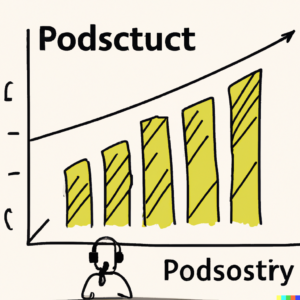There are three ways to approach a podcast work-flow and I see consistent results
1. The Lazy Way
2. The Half-Ass Way
3. The Pro Way

When podcasters get started, much like bloggers, youtubers, etc, they think – I’ll just click record and post what I have. This is not quality content, this is shit. Once in a while someone gets lucky with a funny clip, or an epiphanic moment. This is not the rule, this is rare. Consistent results come from a consistent product of quality. This way is The Lazy Way. It’s fine for getting your feet wet, but will yield poor results long term.
The Half-Ass Way. When you’ve done a pinch of planning, spent some money on a decent microphone, bought some stock music for the intro and outro, and say “like and subscribe” a few times in the show – you think you’re on your way to success. This is merely a stepping stone. This Half-Ass Way allows you to see what kind of effort goes into a decent product.
The Pro Way. Understanding what goes into pre-production, production, and post-production. Here’s my simple explanation of this process. Pre-production means planning content, scheduling, and prepping the guest, for interview style shows. Production is quality control in the recording process and performance or delivery. Post-Production is the cleanup crew for what you missed in the first two steps. Mind you, don’t think you can shine a piece of shit and call it gold.
The major deterrent for investing in The Pro Way is confidence in the product. “I have a great idea but I’m not sure if I can execute.” This goes for inventions as well. If it’s so great, spend some money, make the product and sell it.
Pay attention to the details of your show and you’ll yield improved results. There’s a reason the major production companies are on top.

The Pro Way:
Pre-Production
1. Ideating the show theme/topic or special interest (guest). If you just plan on having a guest on the show, that’s not enough.
2. Preparing the story line. All good art is made up of beautiful contrasting lines. Don’t take my word for it; Kurt Vonnegut Jr. shared this exact sentiment time and again. A great story line has ups and downs. It moves the listener. If it’s stagnant, they will leave.
3. Prepare the production. This includes scheduling all necessary parties for the recording, securing a space, and having your equipment setup and ready to go.
Production
1. With the mics checked and properly gain-staged, the room quiet, the story outline available and all necessary persons present, you hit the magical little red circle (record). This is time for your performance. While self-deprecation seems to be a trend of newbies, it never bodes well. Present yourself as an expert, if you have doubts – become the expert!
Post-Production
1. Enhance the audio quality. In TV and radio, there are loudness expectations, guidelines and even RULES! Loudness is measured in many ways, it’s best to understand it and then manipulate it. Or hire and audio-engineer. All speakers are treated equally. This means that what sounds good on your speakers might sound like hog-food to someone else. Compression, EQ, and some wonderful new de-noising softwares are available.
2. Edit out the crap. Disfluencies, redundancies, recording mistakes and glitches: all of these things need to be cut. Don’t give your listener a reason to exit stage left. How long can you stand watching a TV program with bad reception (a thing that some people may never understand)?
3. Edit for Content! Almost everything in the world of value has been edited, generally by more than one person. The listener is inherently selfish and are looking to serve themselves. Set your ego aside and remember that the job of the content is to hold the listener until the end of the episode.

When your final product is so tight that your skeptical best friend wants to share your show, and brag about knowing the host of a podcast, you’ve made something great. If you have to beg your own mother to listen to the show, it’s crap!
Don’t be lazy, or manage your expectations.







